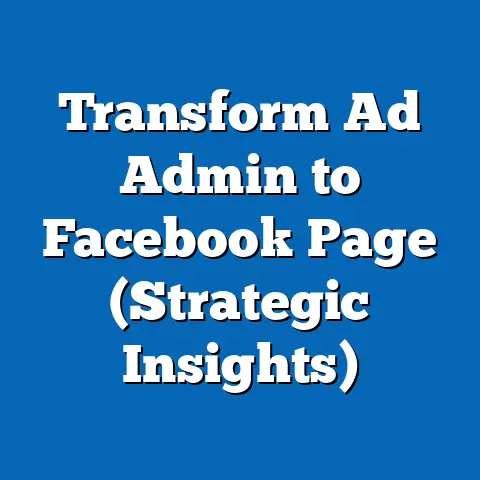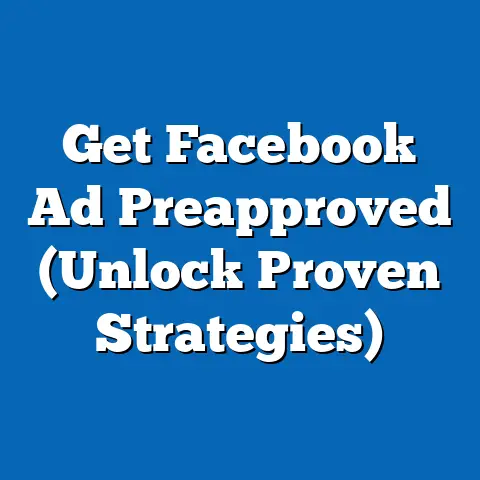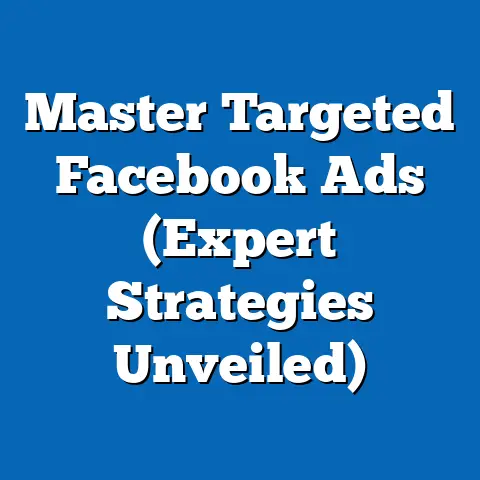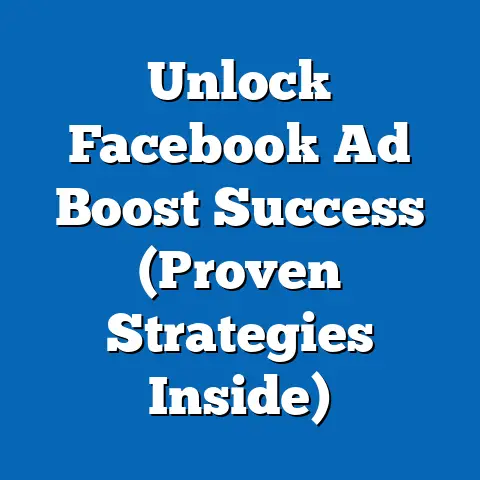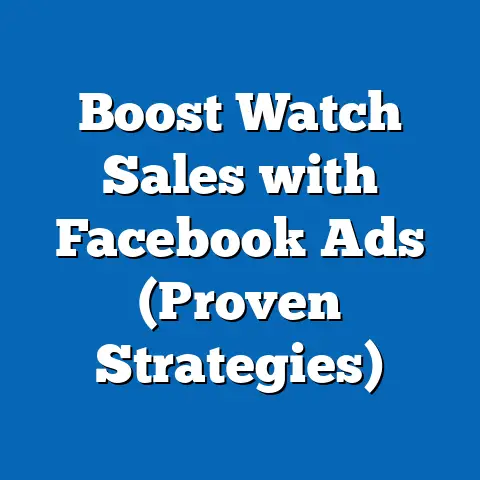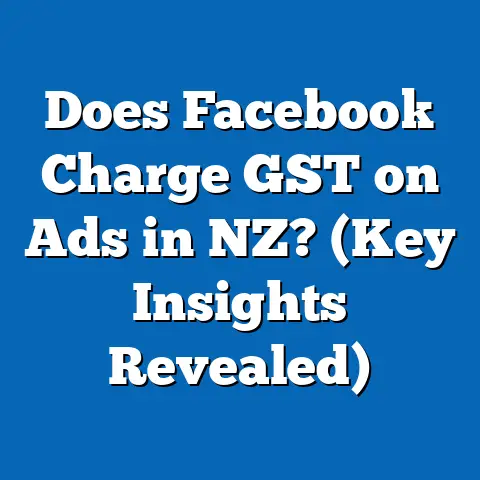Maximize Facebook Ads for Success (Proven Strategies Inside)
Facebook advertising remains a powerhouse in the digital marketing landscape, offering unparalleled reach and targeting precision for businesses of all sizes. As of 2023, Meta (Facebook’s parent company) reports that over 2.9 billion monthly active users engage with the platform, making it one of the largest advertising ecosystems globally. This article delves into the unique aspects of Facebook Ads, key statistical trends, demographic breakdowns, historical performance comparisons, and future projections to equip marketers with proven strategies for success.
What sets Facebook Ads apart is its sophisticated targeting capabilities, fueled by a vast repository of user data, and its ability to adapt to evolving consumer behaviors. According to Statista, global digital ad spending on social media platforms reached $226 billion in 2022, with Facebook accounting for approximately 25% of this market share. This dominance underscores the platform’s critical role in modern marketing strategies.
Moreover, recent data from eMarketer indicates that 78% of marketers worldwide consider Facebook Ads effective for driving conversions, a testament to its unique value proposition. This article will explore how businesses can maximize returns by leveraging demographic insights, historical trends, and cutting-edge strategies. We’ll also look ahead to emerging opportunities as the platform continues to evolve.
The Uniqueness of Facebook Ads: Why It Stands Out
Unmatched Audience Reach and Data Depth
Facebook’s advertising platform is unique due to its sheer scale and the depth of user data it collects. With 2.9 billion monthly active users as of Q2 2023, according to Meta’s investor reports, the platform offers access to nearly 37% of the global population. This reach is complemented by detailed user insights, including interests, behaviors, and demographics, allowing advertisers to create hyper-targeted campaigns.
Unlike other platforms, Facebook’s algorithm integrates data from its ecosystem, including Instagram and WhatsApp, to refine ad delivery. This interconnectedness ensures that ads are not only seen but are also relevant to the viewer, with a reported click-through rate (CTR) averaging 0.90% across industries, per WordStream’s 2023 benchmarks. This is notably higher than platforms like Twitter (now X), which averages around 0.58%.
Additionally, Facebook’s Custom Audiences feature allows businesses to retarget website visitors or upload customer lists for personalized campaigns. This level of precision targeting is a key differentiator, as it drives higher engagement rates—often up to 1.5% for retargeted ads compared to 0.5% for broad campaigns, according to Hootsuite data.
Versatility Across Ad Formats and Objectives
Another unique aspect of Facebook Ads is the variety of ad formats and campaign objectives tailored to diverse business goals. From carousel ads and video ads to lead generation forms and instant experiences, the platform supports creative storytelling and direct response marketing. Statista reports that video ads alone accounted for 54% of ad impressions in 2022, reflecting a growing preference for dynamic content.
Facebook also offers objectives ranging from brand awareness to store traffic, ensuring alignment with specific marketing funnels. For instance, conversion-focused campaigns have shown a 14% higher return on ad spend (ROAS) compared to awareness campaigns, per a 2023 study by Social Media Examiner. This flexibility allows small businesses and global enterprises alike to craft strategies that resonate with their audiences.
The platform’s adaptability to mobile-first users further enhances its uniqueness. With 98.5% of active users accessing Facebook via mobile devices (Meta, 2023), ads are optimized for smaller screens, ensuring seamless user experiences. This mobile dominance is a critical factor in driving engagement, especially among younger demographics.
Key Statistical Trends in Facebook Advertising
Ad Spend and Revenue Growth
Facebook’s advertising revenue has seen consistent growth, reflecting its importance in the digital economy. In 2022, Meta generated $113.6 billion in ad revenue, a 1% increase from 2021 despite economic headwinds, according to their annual report. This resilience highlights advertisers’ trust in the platform’s ability to deliver results even amid inflation and reduced consumer spending.
Global ad spend on Facebook is projected to grow at a compound annual growth rate (CAGR) of 9.3% from 2023 to 2028, per eMarketer forecasts. This growth is driven by increased adoption among small and medium-sized businesses (SMBs), which account for 60% of ad spend on the platform. SMBs are particularly drawn to Facebook’s low entry cost, with average cost-per-click (CPC) at $0.97 compared to Google Ads’ $2.69 (WordStream, 2023).
However, competition is driving up costs in certain industries like finance and insurance, where CPC can exceed $3.77. Marketers must therefore optimize for efficiency, focusing on high-performing ad formats and audiences to maintain profitability.
Engagement and Conversion Metrics
Engagement metrics reveal Facebook’s strength in fostering user interaction. The average engagement rate for organic posts is 0.07%, but paid ads achieve rates closer to 3.2%, according to Sprout Social’s 2023 data. This disparity underscores the value of paid advertising in cutting through algorithmic noise.
Conversion rates also vary widely by industry, with e-commerce campaigns averaging a 9.21% conversion rate compared to 5.31% for B2B sectors (WordStream, 2023). These figures suggest that consumer-focused industries benefit most from direct response ads, while B2B marketers may need longer nurture cycles using lead generation forms.
Moreover, the rise of video content has boosted engagement by 20% year-over-year, with short-form videos (under 60 seconds) achieving 2x higher completion rates than longer formats, per Meta’s internal data. Advertisers are increasingly prioritizing video to capture attention in crowded newsfeeds.
Demographic Breakdowns: Who’s Engaging with Facebook Ads?
Age and Gender Insights
Facebook’s user base spans a wide demographic spectrum, but engagement with ads varies significantly by age and gender. According to Statista (2023), 25-34-year-olds constitute the largest user group at 29.6% of the total audience, followed by 18-24-year-olds at 23.8%. These younger cohorts are highly responsive to ads, with CTRs averaging 1.2% compared to 0.6% for users over 55.
Gender-wise, men make up 56.5% of Facebook’s global user base, while women account for 43.5%. However, women tend to engage more with ads, particularly in retail and beauty sectors, showing a 15% higher click rate than men, per Hootsuite’s 2023 report. This suggests that gender-specific targeting can enhance campaign performance.
Older demographics (55+) are a growing segment, increasing by 10% annually as more seniors adopt social media. While their engagement rates are lower, they exhibit higher purchasing power, making them a valuable audience for luxury goods and health-related products.
Geographic and Socioeconomic Factors
Geographically, Facebook’s largest markets are in Asia-Pacific (43% of users), followed by Europe (14%) and North America (10%), per Meta’s 2023 data. India alone accounts for 314 million users, driven by mobile penetration and affordable data plans. Advertisers targeting emerging markets must consider language localization and cultural nuances, as ads in native languages achieve 30% higher engagement (Sprout Social, 2023).
In terms of socioeconomic status, Facebook Ads are effective across income brackets due to tailored targeting options. Middle-income users ($30,000-$75,000 annually) show the highest ad engagement at 2.1%, while high-income users (over $100,000) convert at higher rates (12%) due to greater disposable income, per eMarketer’s analysis. This highlights the need for segmented strategies based on purchasing power.
Urban users also engage more frequently with ads (1.8% CTR) compared to rural users (0.9% CTR), reflecting differences in internet access and digital literacy. Marketers targeting rural areas may benefit from simplified messaging and mobile-optimized campaigns.
Historical Trend Analysis: How Facebook Ads Have Evolved
Early Days to Algorithmic Precision (2007-2015)
When Facebook Ads launched in 2007, the platform focused on basic banner ads with limited targeting options. Early adoption was slow, with ad revenue at just $764 million in 2010, per historical Meta reports. Engagement was modest, as users were wary of overt advertising on a social platform.
By 2012, the introduction of mobile ads marked a turning point, coinciding with a shift to a mobile-first user base. Ad revenue surged to $4.3 billion that year, a 466% increase from 2010. The rollout of News Feed ads improved visibility, boosting CTRs from 0.2% in 2010 to 0.8% by 2015 (eMarketer historical data).
During this period, Facebook also refined its algorithm, prioritizing relevant content over mass exposure. This shift reduced ad fatigue but increased competition, pushing advertisers to invest in creative and targeted campaigns.
Rise of Video and Data Privacy Concerns (2016-2020)
From 2016 to 2020, video ads emerged as a dominant format, with impressions growing by 300% over five years, per Meta analytics. Ad revenue skyrocketed to $84.2 billion by 2020, driven by SMBs and e-commerce brands leveraging dynamic product ads. Average CPC stabilized at around $0.80, making the platform accessible yet competitive.
However, data privacy scandals, such as the 2018 Cambridge Analytica incident, shook user trust and led to stricter regulations like GDPR in Europe. Ad targeting options were curtailed, reducing reach for some campaigns by 10-15%, according to Social Media Examiner. Marketers adapted by focusing on first-party data and lookalike audiences to maintain effectiveness.
Apple’s iOS 14 update in 2020 further disrupted tracking with App Tracking Transparency (ATT), impacting personalized ad delivery. Meta estimated a $10 billion revenue loss in 2022 due to these changes, highlighting the challenges of balancing privacy and performance.
Post-Pandemic Recovery and AI Integration (2021-2023)
The COVID-19 pandemic accelerated digital adoption, with Facebook ad spend increasing by 25% in 2021 as businesses pivoted online. E-commerce ads saw a 40% uptick in conversions, per WordStream, as lockdowns fueled online shopping. However, supply chain disruptions and inflation in 2022 tempered growth, with ad revenue growth slowing to 1%.
AI-driven tools, such as Advantage+ campaigns introduced in 2022, have since redefined ad optimization. These tools automate creative testing and audience targeting, improving ROAS by 20% for early adopters, per Meta’s case studies. Historical data shows that technology adoption has consistently driven performance gains, a trend likely to continue.
Proven Strategies to Maximize Facebook Ads Success
Leverage Hyper-Targeted Audiences
One of the most effective strategies is to use Facebook’s detailed targeting options to reach niche audiences. Custom Audiences allow retargeting of past customers, achieving conversion rates up to 70% higher than cold audiences, per Hootsuite. Lookalike Audiences, based on existing customer data, can expand reach while maintaining relevance, with a reported 2x higher engagement rate.
Interest-based targeting also works well for prospecting, though it requires testing to avoid overly broad segments. For example, a fitness brand targeting “yoga enthusiasts” might achieve a 1.5% CTR compared to 0.5% for a generic “fitness” audience. Regular audience refinement using Facebook’s Insights tool is critical to sustaining performance.
Marketers should also exclude irrelevant demographics to reduce wasted spend. Excluding users under 18 for luxury products, for instance, can lower CPC by 10-15%, according to industry benchmarks.
Optimize for Mobile and Video Content
Given that 98.5% of users access Facebook via mobile, ads must prioritize mobile-friendly designs. Vertical video formats (9:16 ratio) perform best, with 30% higher completion rates than horizontal formats, per Meta’s 2023 data. Thumb-stopping visuals—bright colors, clear text, and dynamic motion—can boost engagement by 25%.
Short-form video content (under 15 seconds) is particularly effective for awareness campaigns, capturing attention in crowded feeds. E-commerce brands using product demo videos report a 12% lift in conversions compared to static images, per Social Media Examiner. Testing multiple formats ensures optimal resonance with target audiences.
Call-to-action (CTA) buttons like “Shop Now” or “Learn More” should be prominent, as they increase click rates by 2.5x, according to WordStream. Mobile optimization isn’t just a trend—it’s a necessity for maximizing ROI.
Test and Iterate with A/B Testing
A/B testing remains a cornerstone of successful Facebook Ads campaigns. Testing variables like ad copy, visuals, and audience segments can improve CTR by up to 50%, per AdEspresso’s 2023 report. For instance, testing two headlines—“Save 20% Today” versus “Limited Time Offer”—can reveal which drives more urgency.
Budget allocation should favor high-performing variants, with at least 20% of ad spend reserved for testing, according to industry best practices. Facebook’s Campaign Budget Optimization (CBO) automates this process, distributing funds to top-performing ad sets with minimal manual intervention.
Marketers should also monitor frequency metrics to avoid ad fatigue. Ads shown more than 3-4 times to the same user see a 40% drop in engagement, per Sprout Social. Rotating creative assets weekly keeps campaigns fresh and effective.
Utilize AI and Automation Tools
Meta’s Advantage+ suite, including Advantage+ Shopping Campaigns, leverages AI to streamline ad delivery and creative optimization. Early adopters report a 15% reduction in cost-per-acquisition (CPA) and a 20% increase in ROAS, per Meta’s 2023 case studies. These tools are particularly beneficial for SMBs with limited resources.
Automated rules can also pause underperforming ads or scale successful ones based on predefined metrics like CPA or CTR. For example, setting a rule to pause ads with a CPA over $50 ensures budget efficiency. Automation saves time while maintaining performance, a win-win for busy marketers.
However, human oversight remains crucial. AI may over-optimize for short-term gains, neglecting brand-building objectives, so regular strategy reviews are essential.
Focus on Retargeting and Funnel Optimization
Retargeting is a proven tactic for converting warm leads, with 70% of website visitors abandoning carts without purchasing, per Baymard Institute. Dynamic Product Ads (DPAs) retarget these users with personalized product recommendations, achieving conversion rates of 8-10%, per WordStream. Setting up a Facebook Pixel is non-negotiable for tracking and retargeting effectively.
Funnel optimization involves tailoring ads to each stage—awareness, consideration, and conversion. Top-of-funnel video ads build brand recall (60% higher retention than static ads), while bottom-funnel promotions with discounts drive purchases, per eMarketer. Mapping customer journeys ensures messaging aligns with intent.
Cross-platform retargeting, such as syncing campaigns with Instagram, extends reach within Meta’s ecosystem. Users exposed to ads on both platforms are 17% more likely to convert, highlighting the value of integrated strategies.
Future Projections and Emerging Opportunities
Growth in Emerging Markets
Facebook’s user growth is slowing in mature markets like North America and Europe, with a projected 1-2% annual increase through 2028, per eMarketer. However, emerging markets like India, Brazil, and Indonesia are expected to drive 80% of new user additions, fueled by mobile adoption and urbanization. Ad spend in these regions is forecasted to grow at a 12% CAGR, offering untapped potential for global brands.
Localized content will be key to success, as cultural relevance boosts engagement by 40%, per Sprout Social. Marketers should also anticipate lower CPCs in these markets—often under $0.50—making them cost-effective testing grounds for new campaigns.
Privacy regulations will continue to shape ad capabilities, with Meta investing in on-device processing to minimize data exposure. While this may limit targeting precision, it could enhance user trust, potentially increasing ad receptivity by 10-15% over time, per industry analysts.
AI and AR Innovations
AI will play an even larger role in ad optimization, with Meta planning to expand generative AI tools for ad creative by 2025. These tools could reduce content creation costs by 30% while improving personalization, per early trials reported by TechCrunch. Advertisers adopting AI early will likely gain a competitive edge.
Augmented Reality (AR) ads, already in beta for select brands, are projected to account for 10% of ad impressions by 2027, per eMarketer forecasts. AR try-on features for fashion and beauty products have shown a 24% lift in conversions, suggesting strong potential for experiential marketing.
Short-form video will remain dominant, with Reels ads expected to drive 50% of video ad revenue by 2025, per Meta’s projections. Marketers should prioritize snackable, authentic content to align with user preferences.
Evolving Privacy Landscape
The shift to a cookieless future will challenge personalized advertising, with Meta estimating a 5-10% revenue impact by 2025 due to signal loss. However, investments in first-party data solutions, like enhanced lead forms, could offset this by 20-30%, per industry estimates. Brands building direct relationships with customers will be best positioned to adapt.
Regulatory scrutiny will intensify, particularly in Europe and the U.S., potentially increasing compliance costs by 15% for advertisers, per Deloitte’s 2023 outlook. Staying ahead of policy changes and prioritizing transparency will be critical to maintaining campaign effectiveness.
Conclusion: Maximizing ROI in a Dynamic Landscape
Facebook Ads remain a vital tool for businesses seeking to connect with diverse, global audiences. By understanding the platform’s unique strengths—unparalleled reach, data-driven targeting, and versatile formats—marketers can craft campaigns that deliver measurable results. Statistical trends show sustained growth in ad spend and engagement, while demographic insights highlight the importance of tailored strategies.
Historical analysis reveals Facebook’s adaptability, from mobile-first innovations to AI-driven automation, positioning it as a leader amid privacy challenges. Proven strategies like hyper-targeting, mobile optimization, A/B testing, retargeting, and AI adoption empower advertisers to maximize ROI. Looking ahead, growth in emerging markets, advancements in AI and AR, and evolving privacy norms will shape the next era of Facebook advertising.
Success lies in staying agile, leveraging data, and prioritizing user relevance. As the digital landscape evolves, those who adapt to these trends will not only survive but thrive in the competitive world of social media advertising. With a projected $200 billion ad market by 2028, the opportunity is vast—provided marketers harness the right strategies today.

